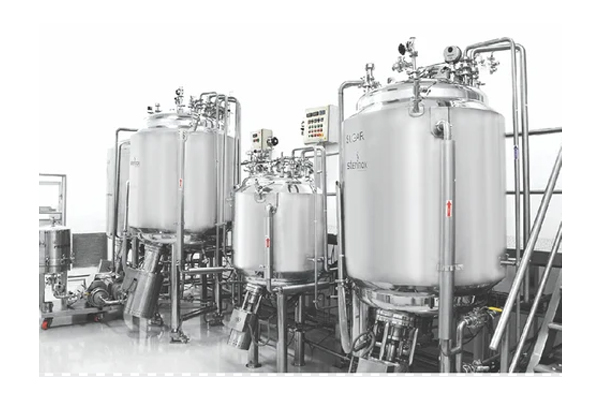WORKING PRINCIPAL
sugar syrup plant working process in a India manufacturing facility typically involves sugar preparation, mixing, filtration, and potentially cooling and storage. The process begins with sugar being graded and sieved, then mixed with water and heated to create a sugar solution. Additives and other ingredients are then incorporated and mixed thoroughly. The solution is then filtered to remove impurities before being cooled and stored in tanks.
CONSTRUCTION
A sugar syrup plant construction process in China involves several key steps, starting with site preparation and foundation work, followed by the installation of machinery and equipment, and finally, commissioning and testing. These plants often incorporate sugar melting vessels, manufacturing vessels, and mixing tanks, along with filtration and other processing equipment.
MANUFACTURING PROCESS
Normally these are cylindrical vessels with either conical or dished bottom vessels with loose type top lids or Fixed Type. In some cases the top is also sealed by dished ends if clients demand for the same. Vessel are jacketed with either steam or electric heating as per clients requirements. Propeller type agitator is provided from the top or bottom side and driven by suitable HP motor as per the vessel capacity. Bottom entry stirrer are provided for closed type vessels. melting is heated in the vessel bet 60 – 80’c as process demands and melted. This melted product is later transferred into the storage vessel. The vessel has a outlet valve fitted with din fittings for connection of suitable pipeline. A 100-mesh conical filter is provided for filtration of wax of any impurities:
CIP/ SIP nozzles is provided at the top of the vessel for cleaning. Suitable nozzles, manholes, valves etc are provided on the vessel. Manufacturing vessel can be subjected to full vacuum.
Ingredients are weighed or metered incrementally into the mixing vessel, with thorough mixing between each addition. A moderate amount of heat is used to reduce the viscosity and so facilitate ease of mixing.
DISSOLVING VESSEL
Sugar Dissolving Tank also named invert sugar tank, widely apply to food, beverage, dairy products, chemical etc industry. Sugar Dissolving Tanks are mainly suitable for dissolving white granulated sugar, also use to melt milk powder, starch etc powder or granular materials. It also play some functions as stirring, dissolving, heating( or cooling, use tap-water cooling), filtrating( strainer) and others. Fast melting speed, high efficiency, is the one of technology equipment for food, drink productions. Sugar Dissolving Tank prepared for series of advantages like convenient to operate, corrosion resistance, powerful production ability, easy to clean and maintenance. External tank body is the stainless steel which was polished and processed to more bright and smooth of the surface of tank.
STORAGE VESSEL
Storage vessel is simple vessel used to store Ointments. It is cylindrical type of vessel with dished bottom, loose top lid or Fixed Type. Bottom valve is provided with din fittings to facilitate the pipeline connection. Its capacity is the same as the manufacturing vessel. Normally storage tanks are more in number so that different types of Ointments can be manufactured and stored.
DETAILS PROCESS
SUGAR PREPRATION :
» Sugar crystals are graded and sieved to remove impurities.
» They are then transferred to a sugar melting vessel.
» Distilled water is added, and the sugar is heated to create a solution.
MIXING AND DISSOLUTION :
» The sugar solution is vigorously mixed with other ingredients, such as active pharmaceutical ingredients, flavorings, or preservatives.
» This can be done using a mixing tank with heating and cooling jackets.
FILTRATION :
» The solution is filtered to remove any remaining impurities or particulate matter.
» A cone filter or basket filter might be used for this purpose.
COOLING AND STORAGE :
» The syrup is cooled to a desired temperature, often using chilled water or steam.
» The cooled syrup is then transferred to storage tanks for holding and further processing.
PIPING AND INSTRUMENTATION :
» Pipes and instrumentation are installed to connect the various equipment and ensure proper flow and control of the syrup-making process.
OPTIONAL STEPS :
» Homogenization : A homogenizer may be used to emulsify and disperse any added ingredients.
» Sterilization: Depending on the application, the syrup may be sterilized to ensure its safety and shelf life.
» Packaging : The final syrup product is then packaged in bottles, containers, or bulk storage for distribution.
